University Anthropology Essay: Human Bipedalism Evolution
VerifiedAdded on 2023/06/03
|8
|2351
|267
Essay
AI Summary
This essay provides a critical analysis of human bipedalism, exploring its historical background and the development of stone-tool technology. It begins by highlighting the unique characteristics of bipedalism and its significance in distinguishing humans from other primates. The essay delves into the history of bipedalism, discussing Darwin's theory of natural selection and the environmental factors that influenced human evolution. It examines the locomotion behaviors of primates, contrasting quadrupedalism with bipedalism, and highlights the anatomical adaptations associated with upright walking. The role of stone tools in human evolution is explored, tracing their origins and significance. The essay further discusses the origins of anatomically modern Homo sapiens, referencing fossil records and the evolution of the human pelvis. It concludes by summarizing the theoretical frameworks of human bipedalism, including the heat theory, the theory of energetic efficiency, and the vigilance theory, and emphasizing the significance of bipedalism in human evolution.
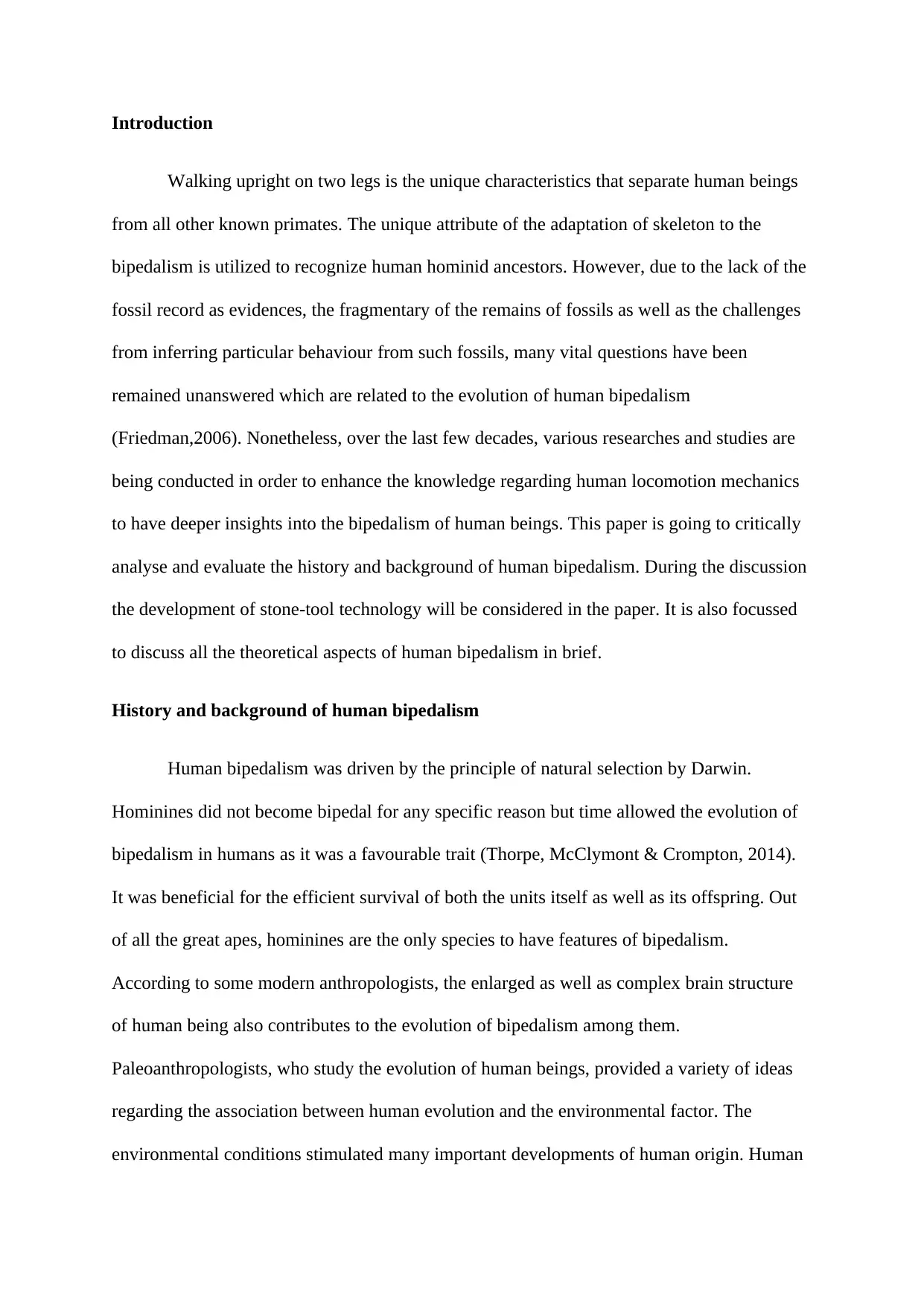
Introduction
Walking upright on two legs is the unique characteristics that separate human beings
from all other known primates. The unique attribute of the adaptation of skeleton to the
bipedalism is utilized to recognize human hominid ancestors. However, due to the lack of the
fossil record as evidences, the fragmentary of the remains of fossils as well as the challenges
from inferring particular behaviour from such fossils, many vital questions have been
remained unanswered which are related to the evolution of human bipedalism
(Friedman,2006). Nonetheless, over the last few decades, various researches and studies are
being conducted in order to enhance the knowledge regarding human locomotion mechanics
to have deeper insights into the bipedalism of human beings. This paper is going to critically
analyse and evaluate the history and background of human bipedalism. During the discussion
the development of stone-tool technology will be considered in the paper. It is also focussed
to discuss all the theoretical aspects of human bipedalism in brief.
History and background of human bipedalism
Human bipedalism was driven by the principle of natural selection by Darwin.
Hominines did not become bipedal for any specific reason but time allowed the evolution of
bipedalism in humans as it was a favourable trait (Thorpe, McClymont & Crompton, 2014).
It was beneficial for the efficient survival of both the units itself as well as its offspring. Out
of all the great apes, hominines are the only species to have features of bipedalism.
According to some modern anthropologists, the enlarged as well as complex brain structure
of human being also contributes to the evolution of bipedalism among them.
Paleoanthropologists, who study the evolution of human beings, provided a variety of ideas
regarding the association between human evolution and the environmental factor. The
environmental conditions stimulated many important developments of human origin. Human
Walking upright on two legs is the unique characteristics that separate human beings
from all other known primates. The unique attribute of the adaptation of skeleton to the
bipedalism is utilized to recognize human hominid ancestors. However, due to the lack of the
fossil record as evidences, the fragmentary of the remains of fossils as well as the challenges
from inferring particular behaviour from such fossils, many vital questions have been
remained unanswered which are related to the evolution of human bipedalism
(Friedman,2006). Nonetheless, over the last few decades, various researches and studies are
being conducted in order to enhance the knowledge regarding human locomotion mechanics
to have deeper insights into the bipedalism of human beings. This paper is going to critically
analyse and evaluate the history and background of human bipedalism. During the discussion
the development of stone-tool technology will be considered in the paper. It is also focussed
to discuss all the theoretical aspects of human bipedalism in brief.
History and background of human bipedalism
Human bipedalism was driven by the principle of natural selection by Darwin.
Hominines did not become bipedal for any specific reason but time allowed the evolution of
bipedalism in humans as it was a favourable trait (Thorpe, McClymont & Crompton, 2014).
It was beneficial for the efficient survival of both the units itself as well as its offspring. Out
of all the great apes, hominines are the only species to have features of bipedalism.
According to some modern anthropologists, the enlarged as well as complex brain structure
of human being also contributes to the evolution of bipedalism among them.
Paleoanthropologists, who study the evolution of human beings, provided a variety of ideas
regarding the association between human evolution and the environmental factor. The
environmental conditions stimulated many important developments of human origin. Human
Paraphrase This Document
Need a fresh take? Get an instant paraphrase of this document with our AI Paraphraser
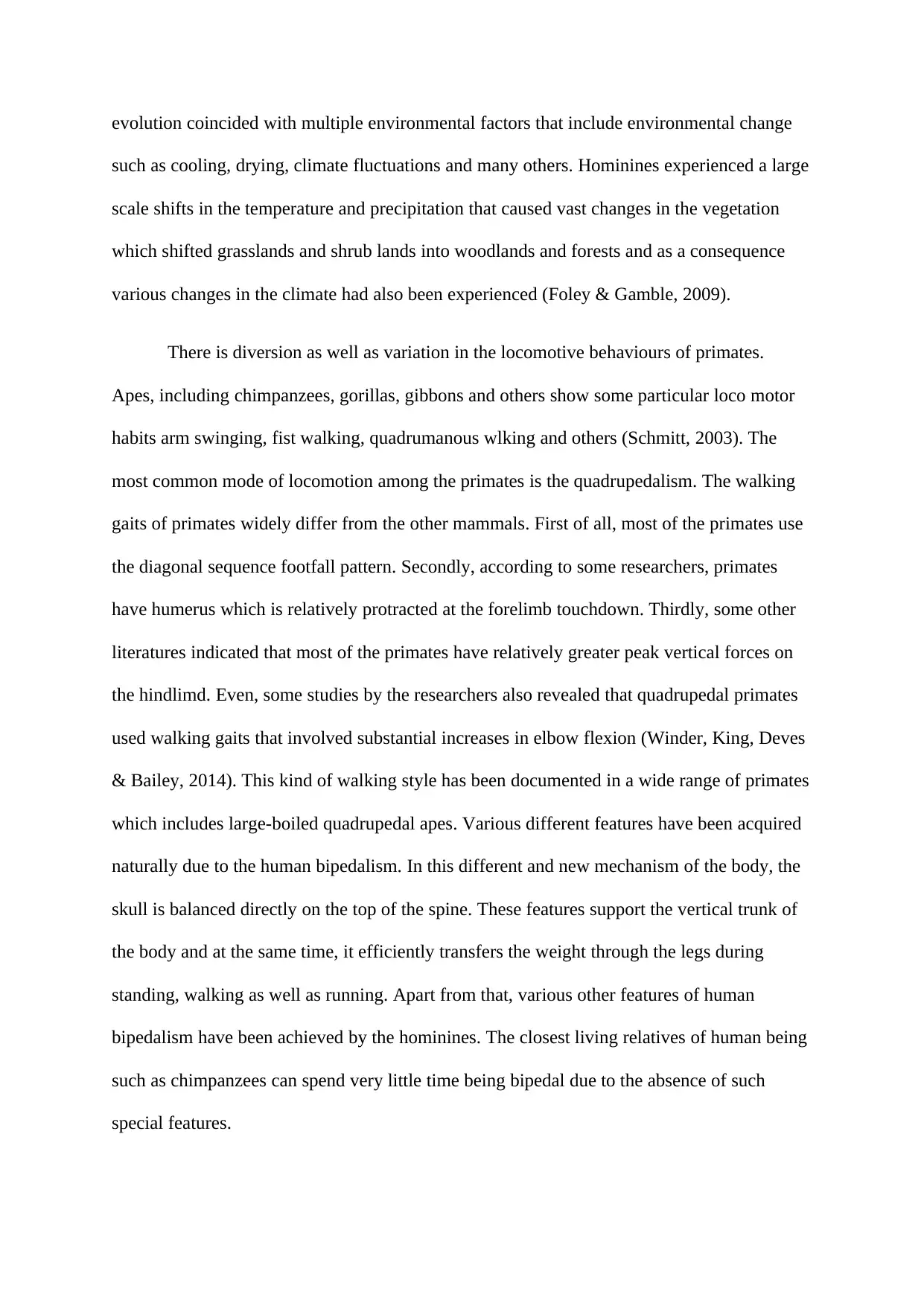
evolution coincided with multiple environmental factors that include environmental change
such as cooling, drying, climate fluctuations and many others. Hominines experienced a large
scale shifts in the temperature and precipitation that caused vast changes in the vegetation
which shifted grasslands and shrub lands into woodlands and forests and as a consequence
various changes in the climate had also been experienced (Foley & Gamble, 2009).
There is diversion as well as variation in the locomotive behaviours of primates.
Apes, including chimpanzees, gorillas, gibbons and others show some particular loco motor
habits arm swinging, fist walking, quadrumanous wlking and others (Schmitt, 2003). The
most common mode of locomotion among the primates is the quadrupedalism. The walking
gaits of primates widely differ from the other mammals. First of all, most of the primates use
the diagonal sequence footfall pattern. Secondly, according to some researchers, primates
have humerus which is relatively protracted at the forelimb touchdown. Thirdly, some other
literatures indicated that most of the primates have relatively greater peak vertical forces on
the hindlimd. Even, some studies by the researchers also revealed that quadrupedal primates
used walking gaits that involved substantial increases in elbow flexion (Winder, King, Deves
& Bailey, 2014). This kind of walking style has been documented in a wide range of primates
which includes large-boiled quadrupedal apes. Various different features have been acquired
naturally due to the human bipedalism. In this different and new mechanism of the body, the
skull is balanced directly on the top of the spine. These features support the vertical trunk of
the body and at the same time, it efficiently transfers the weight through the legs during
standing, walking as well as running. Apart from that, various other features of human
bipedalism have been achieved by the hominines. The closest living relatives of human being
such as chimpanzees can spend very little time being bipedal due to the absence of such
special features.
such as cooling, drying, climate fluctuations and many others. Hominines experienced a large
scale shifts in the temperature and precipitation that caused vast changes in the vegetation
which shifted grasslands and shrub lands into woodlands and forests and as a consequence
various changes in the climate had also been experienced (Foley & Gamble, 2009).
There is diversion as well as variation in the locomotive behaviours of primates.
Apes, including chimpanzees, gorillas, gibbons and others show some particular loco motor
habits arm swinging, fist walking, quadrumanous wlking and others (Schmitt, 2003). The
most common mode of locomotion among the primates is the quadrupedalism. The walking
gaits of primates widely differ from the other mammals. First of all, most of the primates use
the diagonal sequence footfall pattern. Secondly, according to some researchers, primates
have humerus which is relatively protracted at the forelimb touchdown. Thirdly, some other
literatures indicated that most of the primates have relatively greater peak vertical forces on
the hindlimd. Even, some studies by the researchers also revealed that quadrupedal primates
used walking gaits that involved substantial increases in elbow flexion (Winder, King, Deves
& Bailey, 2014). This kind of walking style has been documented in a wide range of primates
which includes large-boiled quadrupedal apes. Various different features have been acquired
naturally due to the human bipedalism. In this different and new mechanism of the body, the
skull is balanced directly on the top of the spine. These features support the vertical trunk of
the body and at the same time, it efficiently transfers the weight through the legs during
standing, walking as well as running. Apart from that, various other features of human
bipedalism have been achieved by the hominines. The closest living relatives of human being
such as chimpanzees can spend very little time being bipedal due to the absence of such
special features.
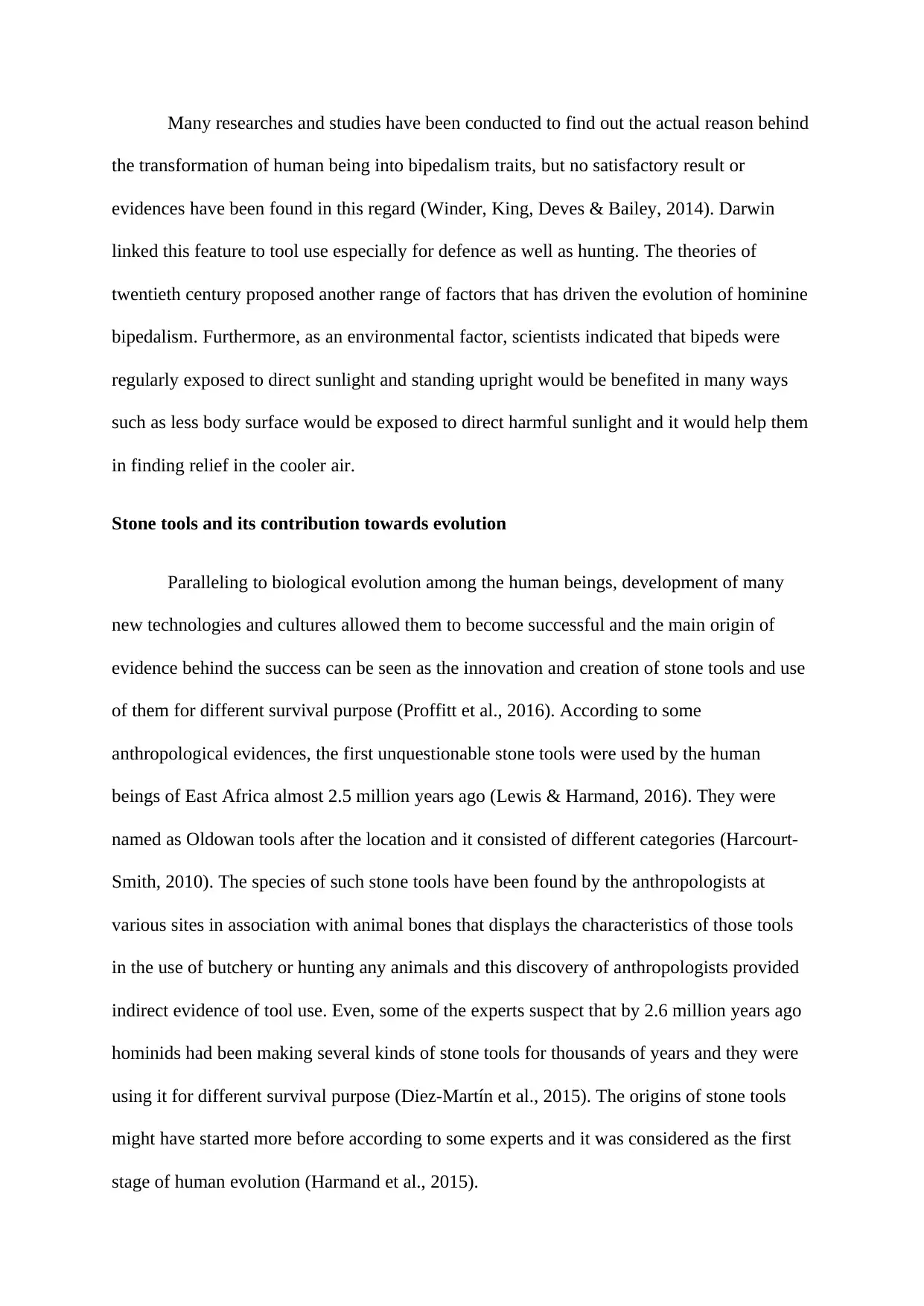
Many researches and studies have been conducted to find out the actual reason behind
the transformation of human being into bipedalism traits, but no satisfactory result or
evidences have been found in this regard (Winder, King, Deves & Bailey, 2014). Darwin
linked this feature to tool use especially for defence as well as hunting. The theories of
twentieth century proposed another range of factors that has driven the evolution of hominine
bipedalism. Furthermore, as an environmental factor, scientists indicated that bipeds were
regularly exposed to direct sunlight and standing upright would be benefited in many ways
such as less body surface would be exposed to direct harmful sunlight and it would help them
in finding relief in the cooler air.
Stone tools and its contribution towards evolution
Paralleling to biological evolution among the human beings, development of many
new technologies and cultures allowed them to become successful and the main origin of
evidence behind the success can be seen as the innovation and creation of stone tools and use
of them for different survival purpose (Proffitt et al., 2016). According to some
anthropological evidences, the first unquestionable stone tools were used by the human
beings of East Africa almost 2.5 million years ago (Lewis & Harmand, 2016). They were
named as Oldowan tools after the location and it consisted of different categories (Harcourt-
Smith, 2010). The species of such stone tools have been found by the anthropologists at
various sites in association with animal bones that displays the characteristics of those tools
in the use of butchery or hunting any animals and this discovery of anthropologists provided
indirect evidence of tool use. Even, some of the experts suspect that by 2.6 million years ago
hominids had been making several kinds of stone tools for thousands of years and they were
using it for different survival purpose (Diez-Martín et al., 2015). The origins of stone tools
might have started more before according to some experts and it was considered as the first
stage of human evolution (Harmand et al., 2015).
the transformation of human being into bipedalism traits, but no satisfactory result or
evidences have been found in this regard (Winder, King, Deves & Bailey, 2014). Darwin
linked this feature to tool use especially for defence as well as hunting. The theories of
twentieth century proposed another range of factors that has driven the evolution of hominine
bipedalism. Furthermore, as an environmental factor, scientists indicated that bipeds were
regularly exposed to direct sunlight and standing upright would be benefited in many ways
such as less body surface would be exposed to direct harmful sunlight and it would help them
in finding relief in the cooler air.
Stone tools and its contribution towards evolution
Paralleling to biological evolution among the human beings, development of many
new technologies and cultures allowed them to become successful and the main origin of
evidence behind the success can be seen as the innovation and creation of stone tools and use
of them for different survival purpose (Proffitt et al., 2016). According to some
anthropological evidences, the first unquestionable stone tools were used by the human
beings of East Africa almost 2.5 million years ago (Lewis & Harmand, 2016). They were
named as Oldowan tools after the location and it consisted of different categories (Harcourt-
Smith, 2010). The species of such stone tools have been found by the anthropologists at
various sites in association with animal bones that displays the characteristics of those tools
in the use of butchery or hunting any animals and this discovery of anthropologists provided
indirect evidence of tool use. Even, some of the experts suspect that by 2.6 million years ago
hominids had been making several kinds of stone tools for thousands of years and they were
using it for different survival purpose (Diez-Martín et al., 2015). The origins of stone tools
might have started more before according to some experts and it was considered as the first
stage of human evolution (Harmand et al., 2015).
⊘ This is a preview!⊘
Do you want full access?
Subscribe today to unlock all pages.

Trusted by 1+ million students worldwide
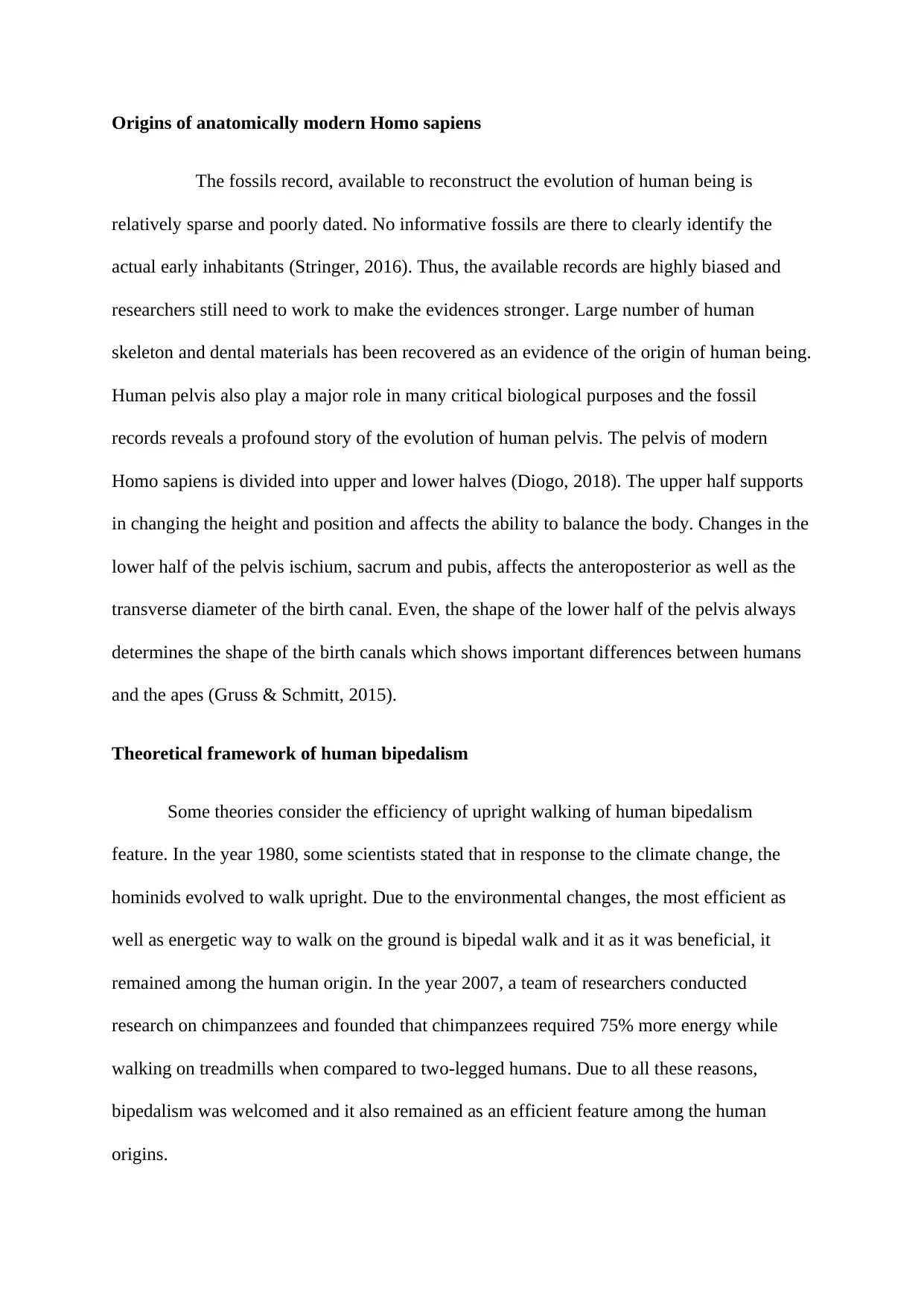
Origins of anatomically modern Homo sapiens
The fossils record, available to reconstruct the evolution of human being is
relatively sparse and poorly dated. No informative fossils are there to clearly identify the
actual early inhabitants (Stringer, 2016). Thus, the available records are highly biased and
researchers still need to work to make the evidences stronger. Large number of human
skeleton and dental materials has been recovered as an evidence of the origin of human being.
Human pelvis also play a major role in many critical biological purposes and the fossil
records reveals a profound story of the evolution of human pelvis. The pelvis of modern
Homo sapiens is divided into upper and lower halves (Diogo, 2018). The upper half supports
in changing the height and position and affects the ability to balance the body. Changes in the
lower half of the pelvis ischium, sacrum and pubis, affects the anteroposterior as well as the
transverse diameter of the birth canal. Even, the shape of the lower half of the pelvis always
determines the shape of the birth canals which shows important differences between humans
and the apes (Gruss & Schmitt, 2015).
Theoretical framework of human bipedalism
Some theories consider the efficiency of upright walking of human bipedalism
feature. In the year 1980, some scientists stated that in response to the climate change, the
hominids evolved to walk upright. Due to the environmental changes, the most efficient as
well as energetic way to walk on the ground is bipedal walk and it as it was beneficial, it
remained among the human origin. In the year 2007, a team of researchers conducted
research on chimpanzees and founded that chimpanzees required 75% more energy while
walking on treadmills when compared to two-legged humans. Due to all these reasons,
bipedalism was welcomed and it also remained as an efficient feature among the human
origins.
The fossils record, available to reconstruct the evolution of human being is
relatively sparse and poorly dated. No informative fossils are there to clearly identify the
actual early inhabitants (Stringer, 2016). Thus, the available records are highly biased and
researchers still need to work to make the evidences stronger. Large number of human
skeleton and dental materials has been recovered as an evidence of the origin of human being.
Human pelvis also play a major role in many critical biological purposes and the fossil
records reveals a profound story of the evolution of human pelvis. The pelvis of modern
Homo sapiens is divided into upper and lower halves (Diogo, 2018). The upper half supports
in changing the height and position and affects the ability to balance the body. Changes in the
lower half of the pelvis ischium, sacrum and pubis, affects the anteroposterior as well as the
transverse diameter of the birth canal. Even, the shape of the lower half of the pelvis always
determines the shape of the birth canals which shows important differences between humans
and the apes (Gruss & Schmitt, 2015).
Theoretical framework of human bipedalism
Some theories consider the efficiency of upright walking of human bipedalism
feature. In the year 1980, some scientists stated that in response to the climate change, the
hominids evolved to walk upright. Due to the environmental changes, the most efficient as
well as energetic way to walk on the ground is bipedal walk and it as it was beneficial, it
remained among the human origin. In the year 2007, a team of researchers conducted
research on chimpanzees and founded that chimpanzees required 75% more energy while
walking on treadmills when compared to two-legged humans. Due to all these reasons,
bipedalism was welcomed and it also remained as an efficient feature among the human
origins.
Paraphrase This Document
Need a fresh take? Get an instant paraphrase of this document with our AI Paraphraser
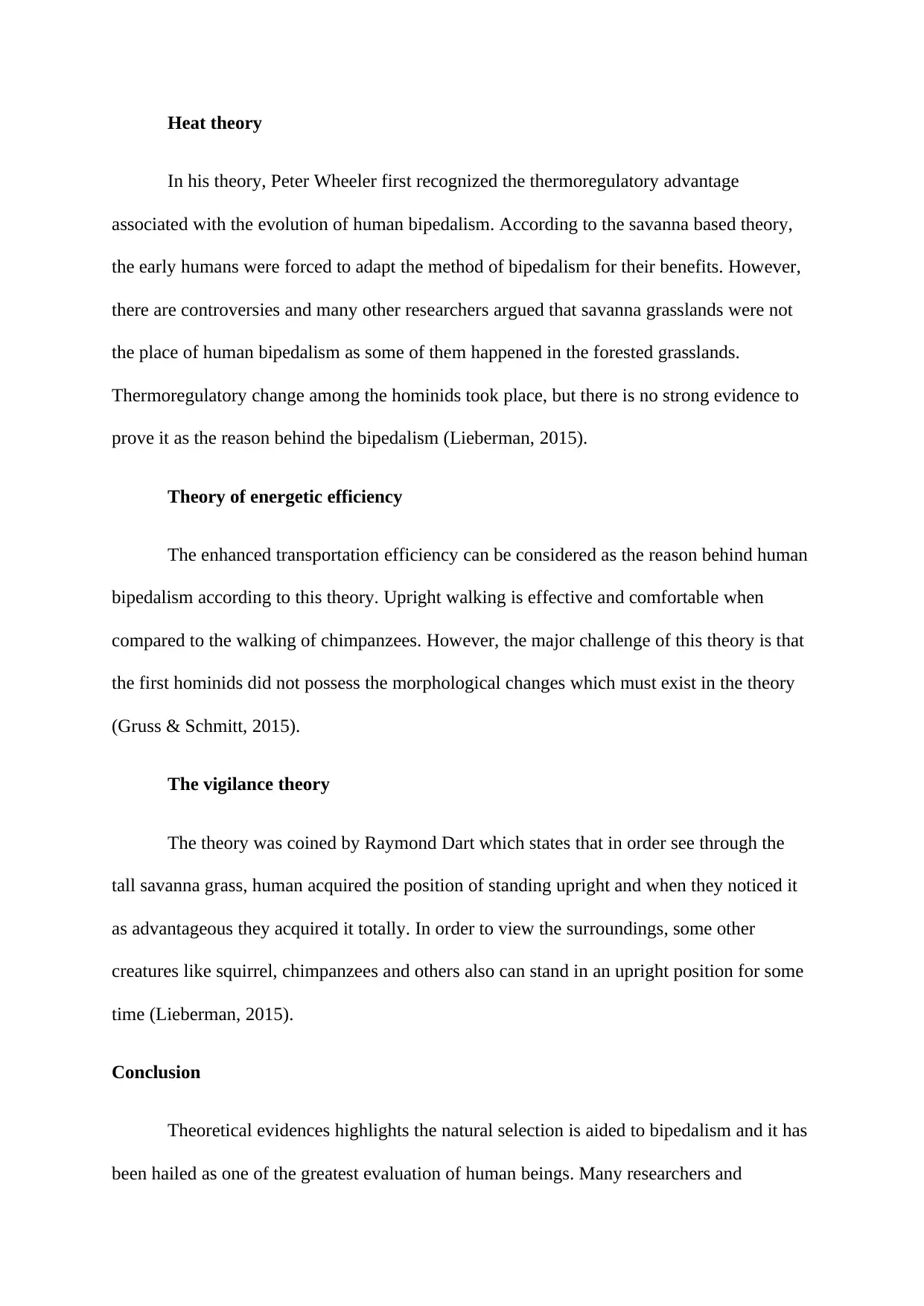
Heat theory
In his theory, Peter Wheeler first recognized the thermoregulatory advantage
associated with the evolution of human bipedalism. According to the savanna based theory,
the early humans were forced to adapt the method of bipedalism for their benefits. However,
there are controversies and many other researchers argued that savanna grasslands were not
the place of human bipedalism as some of them happened in the forested grasslands.
Thermoregulatory change among the hominids took place, but there is no strong evidence to
prove it as the reason behind the bipedalism (Lieberman, 2015).
Theory of energetic efficiency
The enhanced transportation efficiency can be considered as the reason behind human
bipedalism according to this theory. Upright walking is effective and comfortable when
compared to the walking of chimpanzees. However, the major challenge of this theory is that
the first hominids did not possess the morphological changes which must exist in the theory
(Gruss & Schmitt, 2015).
The vigilance theory
The theory was coined by Raymond Dart which states that in order see through the
tall savanna grass, human acquired the position of standing upright and when they noticed it
as advantageous they acquired it totally. In order to view the surroundings, some other
creatures like squirrel, chimpanzees and others also can stand in an upright position for some
time (Lieberman, 2015).
Conclusion
Theoretical evidences highlights the natural selection is aided to bipedalism and it has
been hailed as one of the greatest evaluation of human beings. Many researchers and
In his theory, Peter Wheeler first recognized the thermoregulatory advantage
associated with the evolution of human bipedalism. According to the savanna based theory,
the early humans were forced to adapt the method of bipedalism for their benefits. However,
there are controversies and many other researchers argued that savanna grasslands were not
the place of human bipedalism as some of them happened in the forested grasslands.
Thermoregulatory change among the hominids took place, but there is no strong evidence to
prove it as the reason behind the bipedalism (Lieberman, 2015).
Theory of energetic efficiency
The enhanced transportation efficiency can be considered as the reason behind human
bipedalism according to this theory. Upright walking is effective and comfortable when
compared to the walking of chimpanzees. However, the major challenge of this theory is that
the first hominids did not possess the morphological changes which must exist in the theory
(Gruss & Schmitt, 2015).
The vigilance theory
The theory was coined by Raymond Dart which states that in order see through the
tall savanna grass, human acquired the position of standing upright and when they noticed it
as advantageous they acquired it totally. In order to view the surroundings, some other
creatures like squirrel, chimpanzees and others also can stand in an upright position for some
time (Lieberman, 2015).
Conclusion
Theoretical evidences highlights the natural selection is aided to bipedalism and it has
been hailed as one of the greatest evaluation of human beings. Many researchers and

scientists have also gathered evidences in this regard. This paper clearly highlighted the
origin of Homo sapiens along with its modern anatomical pelvis structure. It also discussed
how creation and utilization of stone tools are associated with the human evolution. Finally it
managed to jot down some theoretical aspects in this regard. Due to the new features, it is
quite obvious that human beings are superior to other primates due to their ability of
bipedalism as well as complex and elevated brain structure.
origin of Homo sapiens along with its modern anatomical pelvis structure. It also discussed
how creation and utilization of stone tools are associated with the human evolution. Finally it
managed to jot down some theoretical aspects in this regard. Due to the new features, it is
quite obvious that human beings are superior to other primates due to their ability of
bipedalism as well as complex and elevated brain structure.
⊘ This is a preview!⊘
Do you want full access?
Subscribe today to unlock all pages.

Trusted by 1+ million students worldwide

References
Diez-Martín, F., Yustos, P. S., Uribelarrea, D., Baquedano, E., Mark, D. F., Mabulla, A., ... &
Yravedra, J. (2015). The origin of the Acheulean: the 1.7 million-year-old site of FLK
West, Olduvai Gorge (Tanzania). Scientific reports, 5, 17839.
Diogo, R. (2018). First detailed anatomical study of bonobos reveals intra-specific variations
and exposes just-so stories of human evolution, bipedalism and tool use. Frontiers in
Ecology and Evolution, 6, 53.
Foley, R., & Gamble, C. (2009). The ecology of social transitions in human
evolution. Philosophical Transactions of the Royal Society B: Biological
Sciences, 364(1533), 3267. Doi: https://dx.doi.org/10.1098%2Frstb.2009.0136
Friedman, M. J. (2006). The Evolution of Hominid Bipedalism. Retrieved from
https://digitalcommons.iwu.edu/cgi/viewcontent.cgi?
article=1013&context=socanth_honproj
Gruss, L. T., & Schmitt, D. (2015). The evolution of the human pelvis: changing adaptations
to bipedalism, obstetrics and thermoregulation. Philosophical Transactions of the
Royal Society B: Biological Sciences, 370(1663), 20140063.
Harcourt-Smith, W. H. (2010). The first hominins and the origins of bipedalism. Evolution:
Education and Outreach, 3(3), 333-340.
Harmand, S., Lewis, J. E., Feibel, C. S., Lepre, C. J., Prat, S., Lenoble, A., ... & Taylor, N.
(2015). 3.3-million-year-old stone tools from Lomekwi 3, West Turkana,
Kenya. Nature, 521(7552), 310.
Diez-Martín, F., Yustos, P. S., Uribelarrea, D., Baquedano, E., Mark, D. F., Mabulla, A., ... &
Yravedra, J. (2015). The origin of the Acheulean: the 1.7 million-year-old site of FLK
West, Olduvai Gorge (Tanzania). Scientific reports, 5, 17839.
Diogo, R. (2018). First detailed anatomical study of bonobos reveals intra-specific variations
and exposes just-so stories of human evolution, bipedalism and tool use. Frontiers in
Ecology and Evolution, 6, 53.
Foley, R., & Gamble, C. (2009). The ecology of social transitions in human
evolution. Philosophical Transactions of the Royal Society B: Biological
Sciences, 364(1533), 3267. Doi: https://dx.doi.org/10.1098%2Frstb.2009.0136
Friedman, M. J. (2006). The Evolution of Hominid Bipedalism. Retrieved from
https://digitalcommons.iwu.edu/cgi/viewcontent.cgi?
article=1013&context=socanth_honproj
Gruss, L. T., & Schmitt, D. (2015). The evolution of the human pelvis: changing adaptations
to bipedalism, obstetrics and thermoregulation. Philosophical Transactions of the
Royal Society B: Biological Sciences, 370(1663), 20140063.
Harcourt-Smith, W. H. (2010). The first hominins and the origins of bipedalism. Evolution:
Education and Outreach, 3(3), 333-340.
Harmand, S., Lewis, J. E., Feibel, C. S., Lepre, C. J., Prat, S., Lenoble, A., ... & Taylor, N.
(2015). 3.3-million-year-old stone tools from Lomekwi 3, West Turkana,
Kenya. Nature, 521(7552), 310.
Paraphrase This Document
Need a fresh take? Get an instant paraphrase of this document with our AI Paraphraser
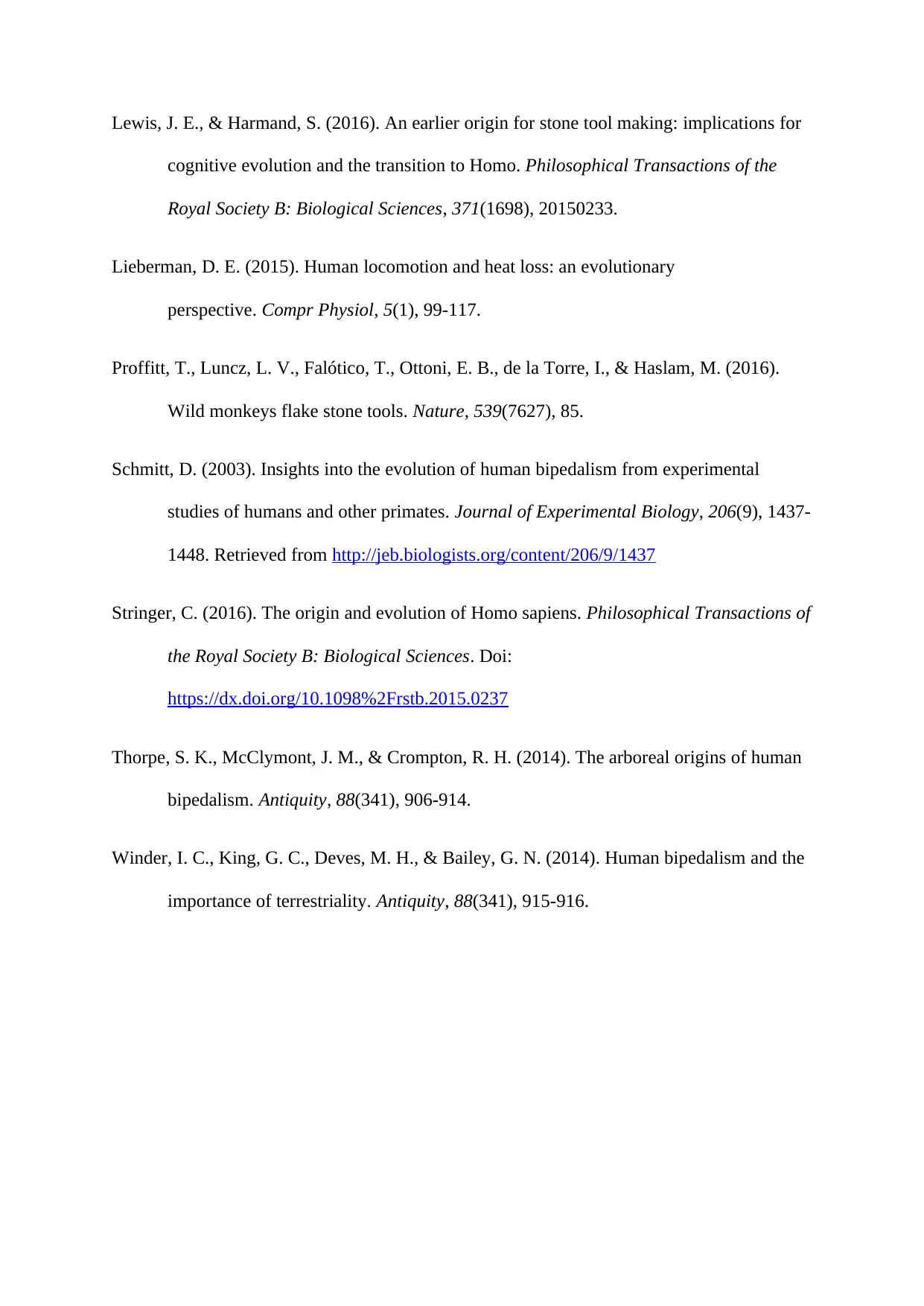
Lewis, J. E., & Harmand, S. (2016). An earlier origin for stone tool making: implications for
cognitive evolution and the transition to Homo. Philosophical Transactions of the
Royal Society B: Biological Sciences, 371(1698), 20150233.
Lieberman, D. E. (2015). Human locomotion and heat loss: an evolutionary
perspective. Compr Physiol, 5(1), 99-117.
Proffitt, T., Luncz, L. V., Falótico, T., Ottoni, E. B., de la Torre, I., & Haslam, M. (2016).
Wild monkeys flake stone tools. Nature, 539(7627), 85.
Schmitt, D. (2003). Insights into the evolution of human bipedalism from experimental
studies of humans and other primates. Journal of Experimental Biology, 206(9), 1437-
1448. Retrieved from http://jeb.biologists.org/content/206/9/1437
Stringer, C. (2016). The origin and evolution of Homo sapiens. Philosophical Transactions of
the Royal Society B: Biological Sciences. Doi:
https://dx.doi.org/10.1098%2Frstb.2015.0237
Thorpe, S. K., McClymont, J. M., & Crompton, R. H. (2014). The arboreal origins of human
bipedalism. Antiquity, 88(341), 906-914.
Winder, I. C., King, G. C., Deves, M. H., & Bailey, G. N. (2014). Human bipedalism and the
importance of terrestriality. Antiquity, 88(341), 915-916.
cognitive evolution and the transition to Homo. Philosophical Transactions of the
Royal Society B: Biological Sciences, 371(1698), 20150233.
Lieberman, D. E. (2015). Human locomotion and heat loss: an evolutionary
perspective. Compr Physiol, 5(1), 99-117.
Proffitt, T., Luncz, L. V., Falótico, T., Ottoni, E. B., de la Torre, I., & Haslam, M. (2016).
Wild monkeys flake stone tools. Nature, 539(7627), 85.
Schmitt, D. (2003). Insights into the evolution of human bipedalism from experimental
studies of humans and other primates. Journal of Experimental Biology, 206(9), 1437-
1448. Retrieved from http://jeb.biologists.org/content/206/9/1437
Stringer, C. (2016). The origin and evolution of Homo sapiens. Philosophical Transactions of
the Royal Society B: Biological Sciences. Doi:
https://dx.doi.org/10.1098%2Frstb.2015.0237
Thorpe, S. K., McClymont, J. M., & Crompton, R. H. (2014). The arboreal origins of human
bipedalism. Antiquity, 88(341), 906-914.
Winder, I. C., King, G. C., Deves, M. H., & Bailey, G. N. (2014). Human bipedalism and the
importance of terrestriality. Antiquity, 88(341), 915-916.
1 out of 8
Related Documents
Your All-in-One AI-Powered Toolkit for Academic Success.
+13062052269
info@desklib.com
Available 24*7 on WhatsApp / Email
![[object Object]](/_next/static/media/star-bottom.7253800d.svg)
Unlock your academic potential
Copyright © 2020–2025 A2Z Services. All Rights Reserved. Developed and managed by ZUCOL.





